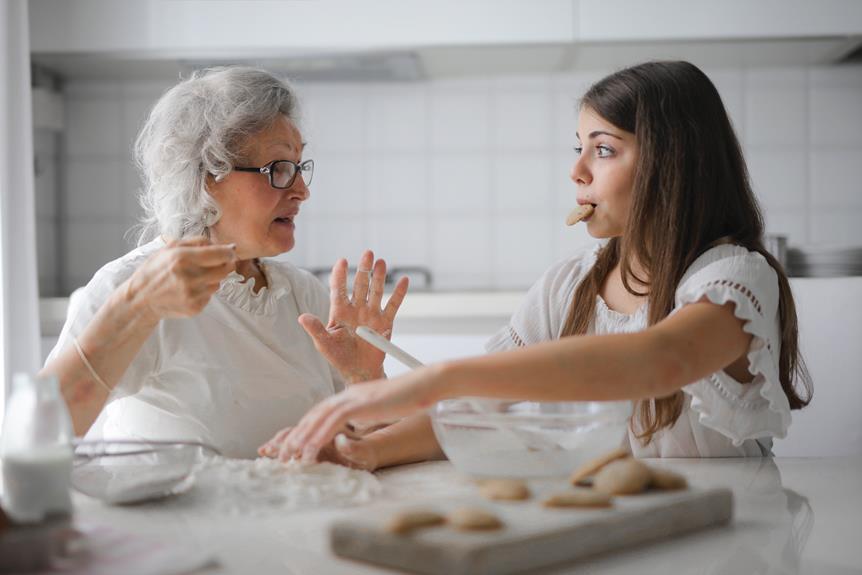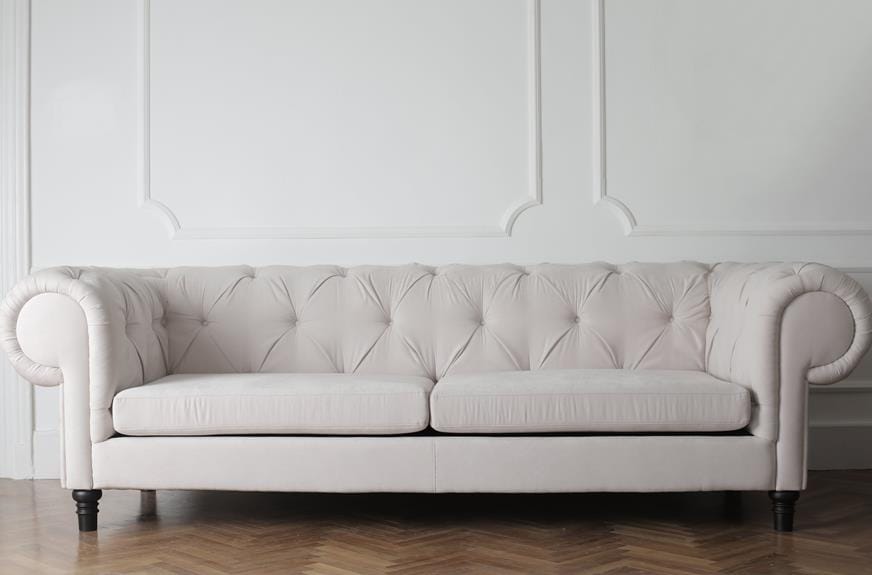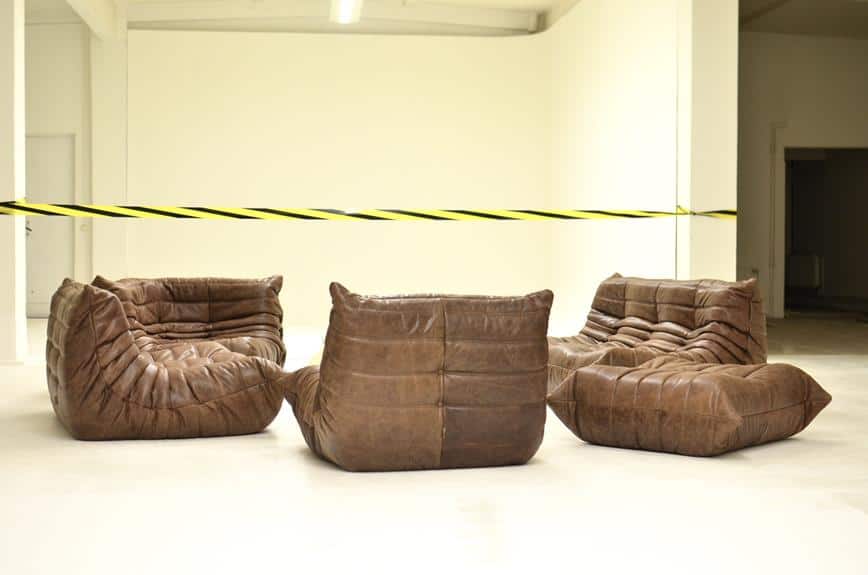To convert a kitchen table into a coffee table, follow these steps:
- Evaluate the table's structure.
- Choose appropriate tools and materials.
- Plan the size adjustment.
The main steps include:
- Cutting the legs to a lower height.
- Sanding the table thoroughly.
- Refinishing it for its new role.
Attach protective pads to the legs to enhance the table's stability and durability.
This guide provides instructions and tips for repurposing your kitchen table and maintaining its condition.
Assessing Your Table
Before starting the transformation of a kitchen table into a coffee table, it's important to assess the table's structure and size to confirm it is a good candidate for the project. Begin by measuring the table's center, which is essential for round tables, to help plan the new layout and spot any design issues.
Sand the table's surface and any additional wood to be used to check the wood's condition and prepare for refinishing or painting. Look for scratches, dents, or uneven areas that need fixing.
Check the table's stability, ensuring the top is securely attached to the base. This is important to maintain the table's strength after reducing its height. Repair any loose or weak joints to prevent future instability.
Evaluate the overall sturdiness of the table to see if it needs extra support or changes. This ensures the table can handle regular use as a coffee table without safety or functional problems.
Lastly, consider the table's dimensions and style to make sure it will fit well in its new location. The proportions are important in the shift from a dining table to a coffee table, and the final product should fit well in its intended environment.
Gathering Necessary Tools
To convert your kitchen table into a coffee table, you'll need the following tools:
- Circular saw: This tool is needed for making precise cuts on the tabletop. Make sure the saw is sharp and set correctly to avoid wood damage.
- Drill: Use the drill to make pilot holes for screws, which helps prevent wood splitting.
- Screwdriver: The screwdriver will be used to secure the screws, ensuring the table is stable.
- Safety glasses and gloves: These are necessary to protect against sawdust and accidents.
Once you have these tools, follow the steps below to convert your kitchen table into a coffee table:
- Use the circular saw to make the necessary cuts on the tabletop.
- Sand the edges after cutting to ensure a smooth finish.
- Apply wood glue to bond and hold the pieces together while the glue sets. Use clamps to secure the pieces in place.
- Once the glue has dried, use the drill to attach the screws, matching the screw type and length to your table's material for a sturdy coffee table.
- Apply a clear varnish to protect and enhance the table's look.
If you plan to add 16-inch metal hairpin legs to your coffee table, make sure to use the right screws and a drill bit for metal to attach them securely.
Deciding on Dimensions
Choosing the right size for a coffee table is essential to maintain balance and functionality in the room. A standard coffee table height is between 16 to 18 inches, matching most seating.
To convert a dining table top to a coffee table, find the center of the table top to cut a circular shape. The new diameter should fit the space, ideally leaving 18 inches of clearance from the surrounding furniture. Dining tables, which are usually 28 to 30 inches high, will need to be reduced in height.
Measure the area where the coffee table will sit to ensure its size is appropriate. A well-sized coffee table should be within reach from all seats and should not dominate or be lost in the room's design.
Shortening the Legs
To convert a dining table into a coffee table, follow these steps:
- Reduce the leg height to between 16 and 18 inches.
- Measure the legs and mark the cut line.
- Verify the measurements to ensure evenness.
- Safely cut the legs with a fine-toothed saw.
- Remember to wear eye protection.
- Keep hands away from the blade.
- Sand the cut edges for smoothness.
- Check the table's stability.
- Make sure it stands evenly.
- Sand further if needed to ensure a level surface.
- This will create a functional coffee table suitable for lounge areas.
Sanding and Refinishing
After shortening the legs of the kitchen table to create a coffee table, the next step is to sand and refinish the surface.
Start with coarse grit sandpaper to remove the old finish and any visible flaws, focusing on the edges and detailed areas where damage is likely.
Next, use medium grit sandpaper to smooth out scratches from the coarse sandpaper and prepare the wood for finishing. If a distressed look is desired, sand the table top unevenly at this stage to simulate wear.
Inspect the table for any remaining imperfections and sand these areas as needed. Finish with fine grit sandpaper to achieve a smooth, even surface.
Once sanded, the table is ready to be stained or painted. Apply the chosen finish uniformly and let it dry thoroughly.
Lastly, apply a clear varnish coat to protect the table and enhance its appearance, ensuring durability for everyday use.
Attaching Protective Pads
After the varnish on the coffee table is dry, the next step is to attach protective pads to the bottom of the table legs. This helps prevent floor damage from scratches and provides stability. These pads are necessary, especially on hardwood, laminate, or vinyl floors, to avoid scuff marks and to keep the table steady.
Choose pads based on the floor type; felt pads are good for hardwood, while rubber or silicone are better for tile to prevent slipping. Pads vary in shape and size to fit the table legs.
To finish the DIY coffee table, attach these pads as they are self-adhesive. Clean and dry the leg surface, then press the pads on firmly. This ensures the table is both attractive and functional without harming the floors.
Styling Your New Coffee Table
After attaching protective pads to your coffee table, style it to match your room's decor. Choose a color or finish that blends with your current furnishings for visual consistency.
Use coasters or placemats to prevent damage from drinks and add style.
For decoration, aim for a balanced look. A decorative tray can organize and display items like books, which add interest and functionality.
Include a small plant or flowers to introduce a natural, lively touch and serve as a focal point.
Feel free to try different layouts with varied heights and materials to personalize your space while maintaining its practicality and harmony with your home's design.
Maintenance Tips
Maintain your converted coffee table regularly to keep it looking good and structurally sound. Check it often for any damage or loose parts to ensure stability, and fix any issues quickly to prevent further harm. If the finish is wearing off, reapply paint or stain to protect the wood and improve the table's look.
Dust and clean the tabletop frequently with a gentle cleaner and a soft cloth, avoiding strong chemicals that could harm the finish. Use furniture pads to prevent scratches and other damage.
For extra protection, apply a clear varnish to the table. This will help guard against moisture and make cleaning up spills easier, while also enhancing the table's appearance.
With these care tips, your repurposed coffee table will stay in good condition for a long time.




